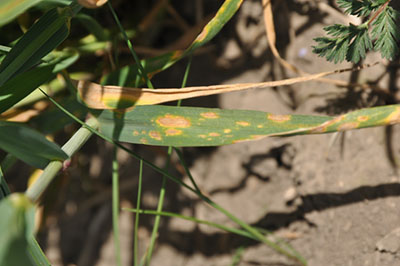Are you seeing spots on your wheat leaves? At the WSU Plant Pest Diagnostic Clinic we have received samples of physiological leaf spot, which is often caused by chloride deficiency.
Chloride is a micronutrient that easily leaches away from the roots and further into the soil with water and with the amount of precipitation we’ve had this season, chloride has left the root zone.
Chloride deficiency causes variable symptoms depending on the weather and wheat variety, with winter wheat being more susceptible than spring wheat. Symptoms start as small yellow to brown, circular to oblong, lesions on lower leaves.
Symptoms start on older leaves and then develop on younger leaves. Older lesions become bleached or tan with a chlorotic halo and merge to create larger lesions.
Older lesions can cause some confusion because they resemble tan spot and Septoria spot. Tan spot is caused by the fungus Pyrenophora tritici-repentis (Dreschlera tritici-repentis) and has oval tan lesions with a yellow or chlorotic halo. Septoria spot is caused by the fungus Septoria tritici and has similar lesions, but will have dark fruiting bodies in the bleached center that look like very small specks.
Tan spot occurs in the Pacific Northwest area but only rarely, especially in the upper canopy. Fungal leaf spots can occur in the lower canopy without moving up, whereas spots due to chloride deficiency move into the upper canopy. Symptoms of chloride deficiency are more obvious during cool and wet springs that is followed by hot sunny weather. Varieties differ in their sensitivity to physiologic leaf spot, so some will be more symptomatic than others with these symptoms are often seen during Feekes 3-5.

It is important to get a correct diagnosis as the management for these issues are different. Look for a dark brown center or the dark fruiting bodies inside the lesions to determine if a fungus is present.
If you are not sure, submit a sample to the Plant Pest Diagnostic Clinic directly or request that your field rep does so. Although tan spot and Septoria spot can be treated with a foliar fungicide, physiologic leaf spot can only be controlled by adding chloride to the soil or plants.
Potassium chloride at a rate of up to 18kg (40 lbs)/acre can be applied by broadcasting up to late jointing stage as long as sufficient rain will move the chloride to the roots, or 4.45kg (10 lbs)/acre of liquid chloride can be applied to the foliage until flag leaf emergence.
Next season, chloride can be applied by banding before or at planting.






Post a comment
Report Abusive Comment